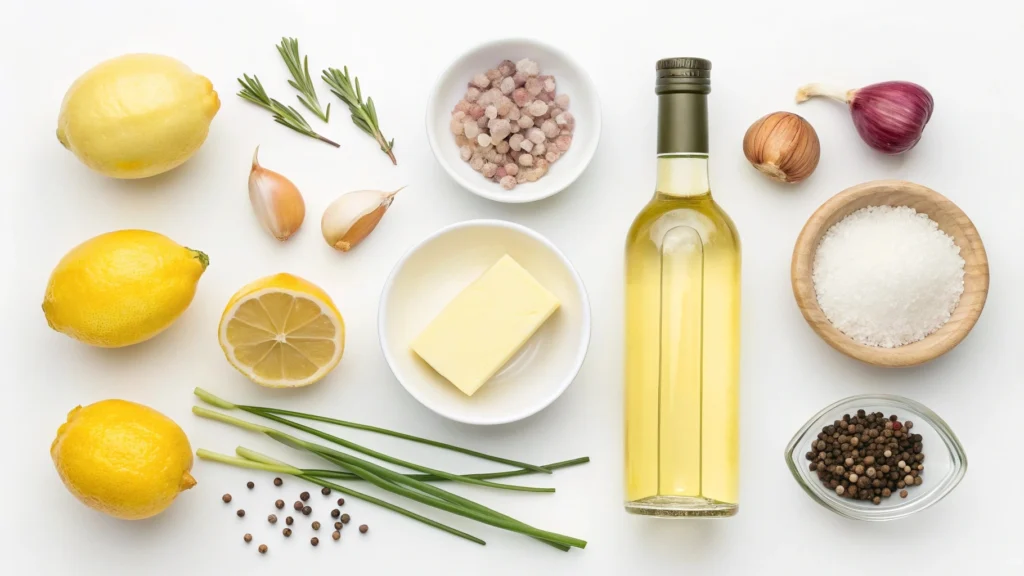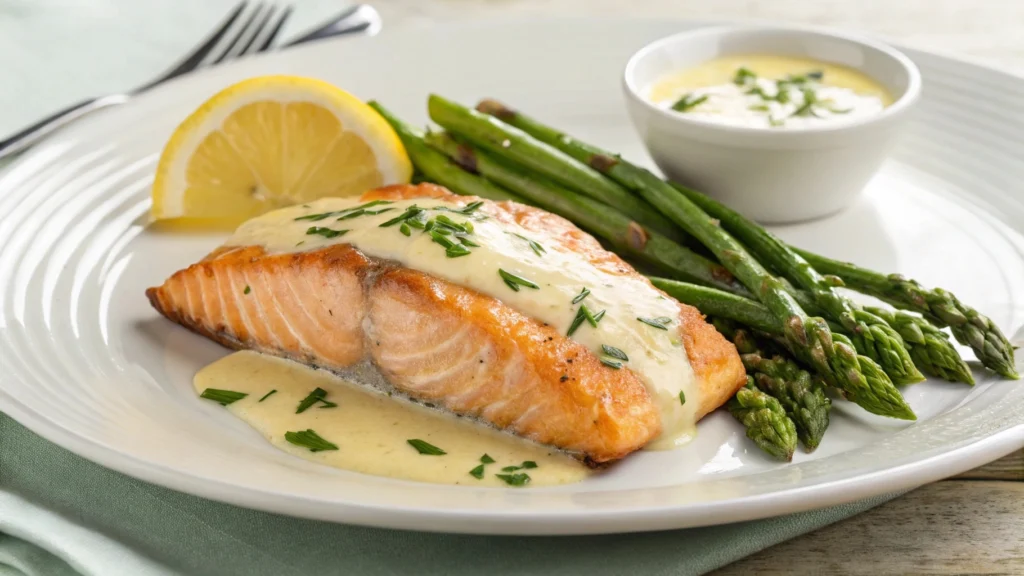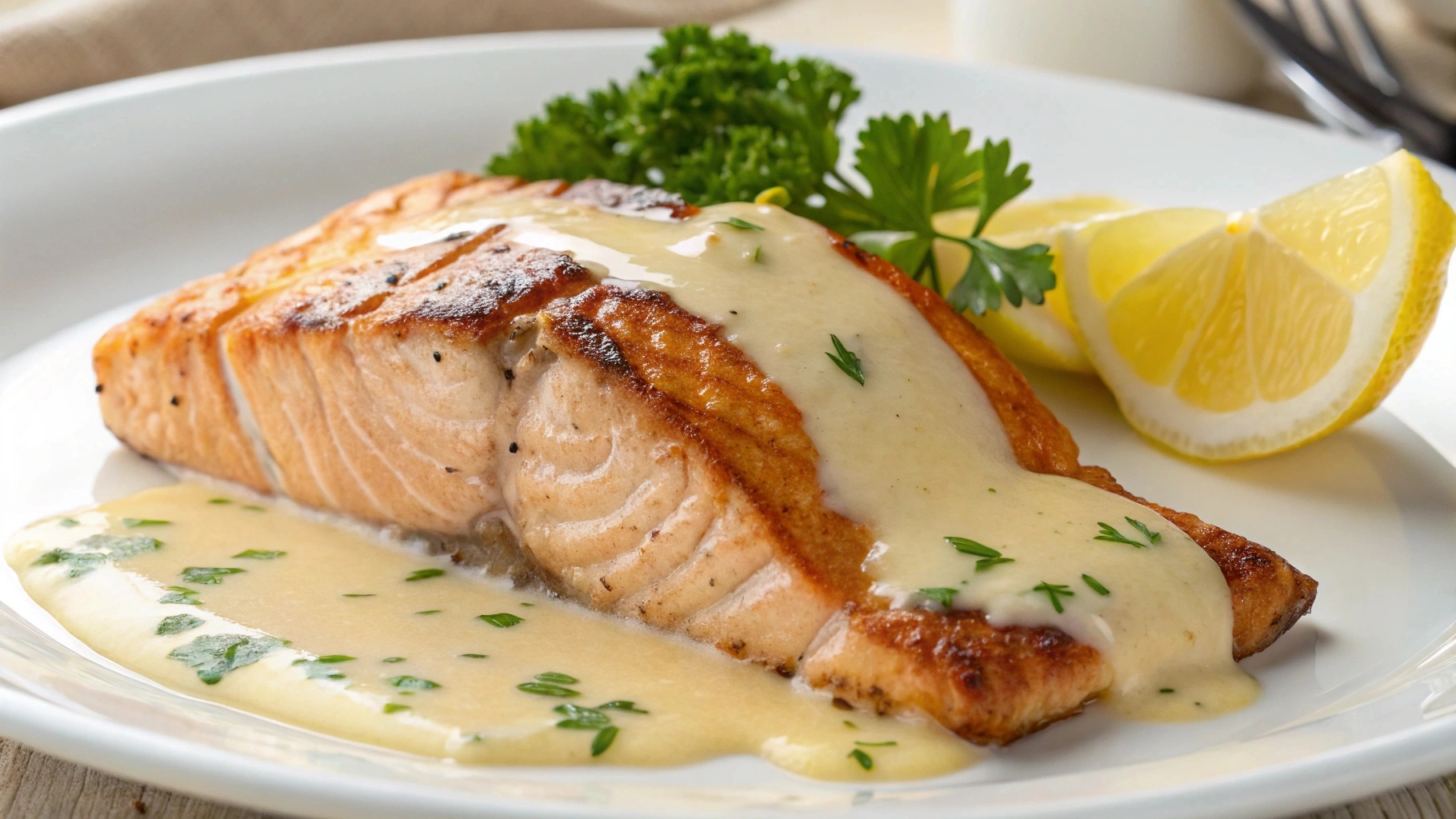Lemon beurre blanc is a rich, creamy, and tangy sauce that has become a staple in French cuisine. The term beurre blanc translates to “white butter,” highlighting its luscious texture and pale hue. This sauce is made by emulsifying butter into a reduced mixture of white wine, shallots, and lemon juice, creating a velvety finish that pairs beautifully with seafood, poultry, and even vegetables.
Whether you’re hosting an elegant dinner party or simply looking to elevate a weeknight meal, mastering lemon beurre blanc can transform your culinary repertoire. Its harmonious balance of creaminess and zest makes it a crowd-pleaser that enhances the natural flavors of your main dish. Plus, it’s deceptively simple to make with just a handful of ingredients.
In this article, we’ll explore everything you need to know about lemon beurre blanc, from its origins and essential ingredients to step-by-step instructions and pairing suggestions. By the end, you’ll be well-equipped to whip up this iconic French sauce and impress your guests with its versatility and sophistication.
Overview of the Article
- What Is Lemon Beurre Blanc?
- Introduction to its origin and culinary significance.
- Origins of Beurre Blanc Sauce
- A brief history of how this French classic came to be.
- Ingredients for Lemon Beurre Blanc
- A detailed breakdown of ingredients and their roles.
- How to Make Lemon Beurre Blanc
- Step-by-step recipe with tips for success.
- Pairing Lemon Beurre Blanc
- Ideal dishes and how this sauce complements different flavors.
- Common Mistakes to Avoid
- Troubleshooting and ensuring consistent results.
Origins of Beurre Blanc Sauce
The origins of beurre blanc sauce, including its lemon-infused variation, trace back to the Loire Valley in France a region known for its rich culinary history and exquisite wines. The sauce was reportedly created by accident in the early 20th century by a chef named Clémence Lefeuvre. According to legend, Lefeuvre intended to prepare a béarnaise sauce but forgot to add tarragon and egg yolks. The result was a simplified, creamy butter sauce that was equally delectable.
Initially, beurre blanc was a simple combination of white wine, vinegar, and butter, served to enhance delicate fish dishes. Over time, variations of the sauce began to emerge, with lemon beurre blanc becoming a favorite for its added citrusy zing. The incorporation of lemon juice and zest gave the sauce a refreshing brightness, making it especially ideal for pairing with seafood.
This sauce epitomizes French culinary techniques, emphasizing the importance of emulsification to achieve its signature silky texture. Its simplicity, elegance, and adaptability have earned it a permanent place in both high-end restaurants and home kitchens worldwide.
Why Lemon Beurre Blanc Stands Out
The lemon variation of beurre blanc stands out due to its perfect balance of acidity and creaminess. The citrus component not only adds freshness but also cuts through the richness of the butter, making it an excellent complement to fatty fish like salmon or buttery shellfish like lobster. Moreover, the sauce’s versatility has made it a favorite among chefs and food enthusiasts alike, as it can also elevate poultry and vegetarian dishes.
Ingredients for Lemon Beurre Blanc
Creating a perfect lemon beurre blanc starts with a few simple yet high-quality ingredients. Each component plays a crucial role in achieving the sauce’s signature velvety texture and tangy flavor. Here’s a breakdown of what you’ll need and why each ingredient is important:

1. Lemons (Juice and Zest)
Lemons are the star ingredient, contributing brightness and acidity that balance the richness of the butter.
- Fresh lemon juice provides a tangy base. Avoid bottled lemon juice, as it lacks the vibrant freshness needed for this sauce.
- Lemon zest adds depth with its aromatic oils, enhancing the overall flavor.
2. Unsalted Butter
Butter is the heart of beurre blanc, giving it its creamy texture and luxurious mouthfeel.
- Always use unsalted butter, as it allows you to control the saltiness of the sauce.
- Cut the butter into small cubes and keep it cold to ensure proper emulsification during cooking.
3. Shallots
Shallots contribute a subtle sweetness and mild onion flavor, which complements the sauce’s acidity.
- Finely dice the shallots to allow for even cooking and a smooth reduction.
4. White Wine
White wine forms the liquid base of the sauce, adding depth and a touch of acidity.
- Choose a dry white wine like Sauvignon Blanc or Pinot Grigio for the best results.
5. White Wine Vinegar (or Champagne Vinegar)
A splash of vinegar intensifies the acidity, helping the sauce achieve its distinctive tang.
- While white wine vinegar is traditional, champagne vinegar can add an elegant twist.
6. Salt and Pepper
Simple seasonings bring out the natural flavors of the ingredients without overpowering the sauce.
- Use kosher salt for better control over seasoning.
- Freshly cracked white pepper is ideal, as it won’t discolor the sauce.
Optional Ingredients for Customization
- Heavy Cream: Some recipes add a splash of cream to stabilize the emulsion and create a thicker sauce.
- Herbs: Fresh herbs like tarragon, parsley, or dill can add an aromatic touch.
Tips for Ingredient Preparation
- Measure and prepare all ingredients ahead of time, as beurre blanc comes together quickly.
- Use high-quality butter and fresh produce for the best flavor.
Example Ingredient List
- 2 medium lemons (juice and zest)
- 1 cup (2 sticks) unsalted butter, cold and cubed
- 2 shallots, finely chopped
- ½ cup dry white wine
- 2 tablespoons white wine vinegar
- Salt and white pepper to taste
Image Suggestion for This Section:
A neatly organized flat-lay of the ingredients: lemons, a block of butter, shallots, a bottle of white wine, and a pinch bowl of salt and pepper.
Part 4: How to Make Lemon Beurre Blanc: Step-by-Step
Mastering lemon beurre blanc is easier than you might think, but it does require attention to detail and patience. This step-by-step guide will help you achieve a smooth, creamy sauce that’s packed with flavor.
Step-by-Step Instructions
Prepare the Ingredients
- Finely dice the shallots and zest the lemons.
- Juice the lemons and measure out the wine and vinegar.
- Cut the butter into small cubes and keep it chilled.
Create the Reduction
- In a medium saucepan, combine the chopped shallots, white wine, white wine vinegar, and lemon juice.
- Place the saucepan over medium heat and bring the mixture to a gentle simmer.
- Reduce the liquid until it has decreased to about 2–3 tablespoons. This intensifies the flavors and ensures the sauce isn’t too runny.
Add Butter Gradually
- Lower the heat to medium-low. Begin adding the cold butter cubes to the reduction one piece at a time.
- Whisk continuously, allowing each cube to melt and emulsify into the sauce before adding the next.
- Continue this process until all the butter is incorporated.
Strain the Sauce (Optional)
- If you prefer a smooth sauce without bits of shallots, strain the sauce through a fine mesh sieve into a clean saucepan or bowl.
- If you enjoy the texture of the shallots, you can skip this step.
Adjust Seasoning
- Taste the sauce and add salt and white pepper as needed.
- Stir in lemon zest for added brightness and aroma.
Serve Immediately
- Lemon beurre blanc is best served warm and freshly made.
- Drizzle it over your dish right before serving to maintain its creamy texture.
Key Tips for Success
- Keep the Butter Cold:
Cold butter is essential for proper emulsification. Adding warm butter can cause the sauce to separate. - Whisk Continuously:
Constant whisking ensures that the butter and reduction blend smoothly into a creamy consistency. - Avoid Overheating:
High heat can cause the sauce to break. Work over medium-low heat for best results. - Serve Fresh:
Beurre blanc doesn’t reheat well, as the emulsion can break. Make it just before serving.
Troubleshooting Common Issues
- Separated Sauce:
If your sauce separates, remove it from the heat and whisk in a teaspoon of cold water to bring it back together. - Overly Tangy Sauce:
Balance the acidity with a small pinch of sugar or an additional cube of butter.
A process shot showing butter being whisked into a saucepan with steam rising, highlighting the creamy texture of the sauce as it forms.
Pairing Lemon Beurre Blanc with Dishes
Lemon beurre blanc’s creamy texture and bright, tangy flavor make it a versatile companion for a variety of dishes. It’s especially renowned for its ability to elevate seafood, poultry, and vegetarian options. Let’s explore the best ways to pair this exquisite sauce and how it complements different ingredients.
1. Pairing Lemon Beurre Blanc with Seafood
The classic pairing for lemon beurre blanc is seafood. The sauce’s acidity and buttery richness balance the delicate flavors of fish and shellfish.
Perfect Seafood Matches:
- Salmon:
The richness of salmon pairs wonderfully with the creamy yet tangy notes of lemon beurre blanc. Drizzle it over grilled or pan-seared salmon for a restaurant-quality meal. - Scallops:
Sear scallops to golden perfection and finish them with a generous spoonful of the sauce for a decadent dish. - Lobster and Crab:
These luxurious shellfish dishes benefit from the sauce’s subtle citrus zest, enhancing their natural sweetness. - White Fish:
Cod, halibut, or sole are light and flaky, making them ideal for soaking up the sauce’s velvety goodness.
2. Enhancing Poultry with Lemon Beurre Blanc
Lemon beurre blanc can bring elegance to poultry dishes, particularly chicken or turkey. Its buttery richness keeps lean poultry moist, while the lemon cuts through heavier flavors.
Ideas for Pairing with Poultry:
- Grilled or Roasted Chicken:
Pour the sauce over a juicy chicken breast or thigh to add a sophisticated touch. - Stuffed Turkey Breast:
Serve alongside turkey breast stuffed with herbs or spinach for a festive meal. - Duck:
The tangy lemon contrasts beautifully with duck’s rich and gamey flavor.
3. Vegetarian Dishes with Lemon Beurre Blanc
Lemon beurre blanc isn’t just for meat and seafood it works beautifully with vegetarian dishes, too. Its richness complements earthy vegetables and grains, while the citrus enhances their natural flavors.
Top Vegetarian Pairings:
- Steamed or Roasted Vegetables:
Asparagus, green beans, and Brussels sprouts shine when drizzled with this sauce. - Potatoes:
Serve over roasted or mashed potatoes for a decadent side dish. - Rice and Risotto:
Use the sauce as a finishing touch on creamy risottos or plain steamed rice. - Grilled Tofu or Paneer:
These proteins soak up the sauce’s flavors and pair beautifully with its creamy texture.
4. Pairing Lemon Beurre Blanc with Pasta
While not a traditional pairing, lemon beurre blanc can also be used as a sauce for light pasta dishes. Toss it with angel hair pasta, capers, and fresh herbs for a quick and elegant meal.
Flavor Enhancements with Herbs and Add-Ins
While the sauce stands beautifully on its own, you can customize it to complement your dish even further.
- Herbs: Add fresh dill, parsley, or chives for an aromatic twist.
- Capers: Incorporate capers for an extra tangy and briny dimension.
- Garlic: A hint of garlic can add warmth and depth.
Presentation Tips for Serving
- Serve lemon beurre blanc in a small sauce boat or ramekin alongside your dish for an elegant touch.
- Drizzle the sauce sparingly over the dish to let its vibrant color and texture shine.
Common Mistakes to Avoid When Making Lemon Beurre Blanc
Creating the perfect lemon beurre blanc is all about technique. While the process is simple, a few common mistakes can result in a sauce that’s too thin, overly tangy, or separated. Here’s how to troubleshoot and avoid these pitfalls:
1. Overheating the Sauce
- Problem: High heat can cause the butter to separate from the liquid, leading to a broken sauce.
- Solution: Always work over low to medium-low heat, especially when whisking in the butter. If the sauce gets too hot, remove it from the heat and allow it to cool slightly before continuing.
2. Adding Butter Too Quickly
- Problem: Dumping in too much butter at once prevents proper emulsification, resulting in a greasy or lumpy sauce.
- Solution: Add the butter one cube at a time, whisking thoroughly after each addition.
3. Skipping the Reduction Step
- Problem: Failing to reduce the wine and vinegar mixture enough can leave the sauce watery and weak in flavor.
- Solution: Simmer the reduction until it has concentrated to about 2–3 tablespoons before adding butter.
4. Using Warm Butter
- Problem: Warm or melted butter doesn’t emulsify as well, leading to a thin, runny sauce.
- Solution: Always use cold, cubed butter straight from the fridge.
5. Over-Acidity
- Problem: Using too much lemon juice or vinegar can make the sauce excessively tangy, overwhelming the dish.
- Solution: Start with the recommended amounts and taste as you go. You can always add more lemon juice at the end if needed.
6. Reheating the Sauce
- Problem: Beurre blanc does not reheat well and can easily separate when warmed.
- Solution: Prepare the sauce just before serving and keep it warm by placing the saucepan over a double boiler or in a warm water bath.

Frequently Asked Questions (FAQs)
Q1: Can I make lemon beurre blanc ahead of time?
A: It’s best to make lemon beurre blanc fresh, as it doesn’t store or reheat well. However, you can prepare the reduction ahead of time and finish the sauce by whisking in the butter just before serving.
Q2: How can I fix a broken sauce?
A: If the sauce separates, remove it from the heat and whisk in a teaspoon of cold water or an ice cube. This can help bring the emulsion back together.
Q3: Can I substitute ingredients like wine or vinegar?
A: Yes, you can use alternatives like apple cider vinegar or a splash of lemon juice in place of white wine vinegar. For a non-alcoholic version, use white grape juice or chicken broth instead of wine.
Q4: What dishes pair best with lemon beurre blanc?
A: Lemon beurre blanc pairs beautifully with seafood (like salmon, scallops, and lobster), poultry (grilled or roasted chicken), and vegetarian options (steamed vegetables, potatoes, and risottos).
Q5: Why does my sauce taste too rich or heavy?
A: The sauce might have too much butter or lack enough acidity. Add a splash of lemon juice or vinegar to balance the richness.
Q6: Can I add other flavors to the sauce?
A: Absolutely! You can customize your lemon beurre blanc with fresh herbs like dill or parsley, capers for tanginess, or garlic for depth.
Conclusion: Mastering Lemon Beurre Blanc
Lemon beurre blanc is a true gem in French cuisine, celebrated for its rich, creamy texture and zesty flavor. By following these tips and troubleshooting techniques, you can confidently prepare this versatile sauce at home. Whether paired with seafood, poultry, or vegetarian dishes, it has the power to transform a simple meal into an elegant masterpiece.
Take the time to master this classic recipe, and you’ll always have an impressive go-to sauce in your culinary repertoire. Happy cooking!
Image Suggestion for This Section:
A close-up shot of a spoon drizzling lemon beurre blanc over a perfectly seared scallop, showcasing the sauce’s creamy texture and vibrant color.

